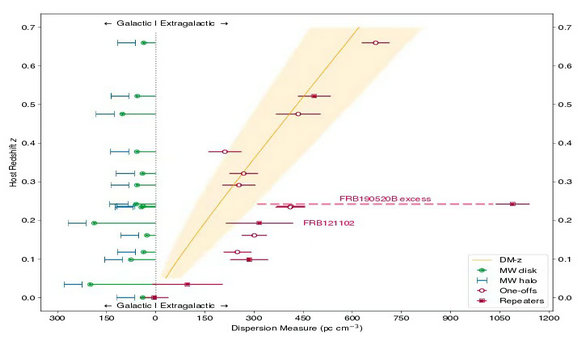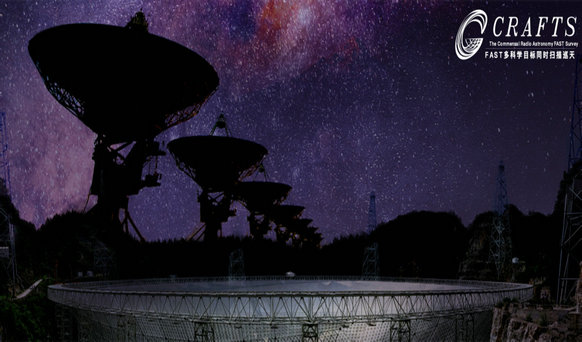CRAFTS Discovers Younger and Weirder Brother of First Repeating Fast Radio Burst
Fast radio bursts (FRBs) are the brightest radio transients in the Universe. Little is known about the intrinsic characteristics. Even the most simple, descriptive questions, such as "Do all FRBs repeat?" remain unanswered.
So far, less than 5% of all the hundreds of FRBs have been seen to repeat. Only a few are persistently active, providing precious glances into their secrets.
Now, an international team led by Dr. LI Di from the National Astronomical Observatories of the Chinese Academy of Sciences (NAOC) has discovered and localized an active repeating fast radio burst, FRB 190520B, in a metal-poor dwarf galaxy at a redshift of z=0.241. This new and strange repeater was discovered by the Commensal Radio Astronomy FAST Survey (CRAFTS), which is led by Dr. LI Di and is one of five legacy programs of the Five-hundred-meter Aperture Spherical radio Telescope (FAST) observatory.
The work was published in Nature on June 8.
The initial discovery was made by Dr.NIU Chen-hui of NAOC through processing the CRAFTS’s scan from May 20, 2019. Based on successful JVLA observations in July 2020, Dr. Casey Law of Caltech led the sub-arcsecond localization analysis and Dr. Wenfei Yu of Shanghai Observatory led the identification of an associated persistent radio source (PRS). Immediately after, Dr. TSAI Chaowei led the galaxy identification efforts, primarily with the Palomar 200-inchandthe Keck telescopes.
The special traits of FRB 190520B include: With 80% of its dispersion measure (DM) attributed to the host galaxy, it has the highest ambient electron density of all FRBs; It is confirmed to be associated with a compact PRS, thus making it only the second such counterpart to be identified, after discovery of the first repeater FRB 121102A; it shows reliable bursting behaviors, i.e. it never turns off since its discovery, the only FRB known so far to be so persistently active.
Further analysis of the scattering characteristics suggests that most of the local DM is contributed by electrons close to the FRB source. This is also consistent with the fact that PRS brightness would require 20 times the star formation rate of its host galaxy if the PRS originated from across the galaxy. FRB190520B seems to reside in a complex plasma environment with characteristics resembling those of a super luminous supernova, thus suggesting the FRB may be a "newborn." This discovery hints at an evolutionary picture of FRBs.
FRB 121102A is the first repeating FRB ever discovered and the first to be localized. It also used to be the only FRB associated with a compact PRS. Being extremely active and residing in a complex electromagnetic environment, FRB 190520B’s behavior is similar to FRB 121102A; it is just more extreme in these aspects.
After the initial posting of this discovery, more in-depth analysis and modeling for this source have been published, including a polarization analysis, scattering timescale models, and supernova origin models, etc.
"We further postulate that FRB 121102A and FRB 190520B represent the initial stage of an evolving FRB population. A coherent picture of the origin and evolution of FRBs is likely to emerge in just a few years," said Dr. LI.
This paper is available at https://www.nature.com/articles/s41586-022-04755-5

Fig. 1: The electron density of FRB 190520B's host galaxy is greater than that of the host galaxies of all other FRB sources. (Image by Niu et al. 2022)

Fig. 2: The discovery was made by the CRAFTS survey using the FAST telescope (shown at the bottom) and the JVLA array (shown in silhouette). (Image by NAOC)